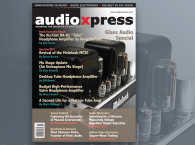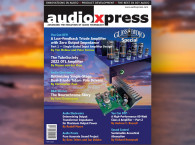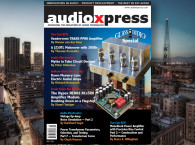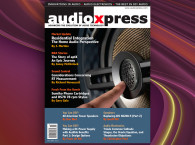 The November 2019 edition of audioXpress is now available with a wide range of technical topics in audio electronics and design. We review the Benchmark LA4 Line Amplifier and the new Hooke Verse Bluetooth Binaural Recording Headphones. Jan Didden proposes an updated version of his High-Voltage Delay for Tube Amplifiers, and Thomas Zarbo, Jr. explains how to build his Tenacious Bass-8 Powered Subwoofer. And, learn more about Data-Over-Sound, MU amplification topologies, and Auverdion’s Aurora open-source DSP platform. Now available!
The November 2019 edition of audioXpress is now available with a wide range of technical topics in audio electronics and design. We review the Benchmark LA4 Line Amplifier and the new Hooke Verse Bluetooth Binaural Recording Headphones. Jan Didden proposes an updated version of his High-Voltage Delay for Tube Amplifiers, and Thomas Zarbo, Jr. explains how to build his Tenacious Bass-8 Powered Subwoofer. And, learn more about Data-Over-Sound, MU amplification topologies, and Auverdion’s Aurora open-source DSP platform. Now available!
The November 2019 edition of audioXpress reviews another example of audio excellence coming from Benchmark Media Systems, the upstate New York audio manufacturer. We think very highly of the products that Benchmark and John Siau, the company's director of engineering, have been launching in the market - and I'm certain our readers share that opinion. This month, Gary Galo wrote the definitive review of the new Benchmark HPA4 Headphone/Line Amplifier, in reality two products in one, combining the LA4 Line Amplifier introduced in 2018 with a headphone amplifier based on the same THX Achromatic Audio Amplifier (AAA) technology used in the acclaimed AHB2 power amplifier (reviewed in audioXpress, April 2015). Galo has reviewed other Benchmark products and there is no one better than him to explain in detail why this is another outstanding engineering achievement.
In another review for this edition, Luke McCready extensively tested the Hooke Verse Bluetooth Binaural Recording Headphones. Part Bluetooth headphones and part wireless binaural recording device, the Hooke Verse aims "to empower creators-on-the-go with three-dimensional recording." In other words, this is the first binaural recording device (in-ear headphones with external microphones) that wirelessly transmits the audio to an app on a smartphone, allowing people to record what they hear, and keep it in sync with the video they record with the smartphone. It is a good idea, and McCready tells us what he found out.
For audioXpress November 2019, we have not only great articles but we also have a new regular columnist. We are honored to have Michael Steffes writing about audio integrated circuits and audio electronics. In a career spanning five different major IC vendors, and more than 32 years in High Speed Signal Path IC development, Steffes has participated in the introduction of more than 150 industry leading amplifier products, setting many of the now standard practices in high speed amplifier characterization curves, publishing over 25 application notes and a growing list of contributed articles from 1989 onward. In his first article for audioXpress, Steffes asks: Can Audio Experts Learn from High-Speed Amplifier Developments? We are certain that our readers will appreciate his topics.
In his Sound Control column, Richard Honeycutt continues to explore how the field of acoustics deals with sound in buildings, sound in outdoor environments, the effects of sound on people and other animals, and many other aspects of sound. After addressing community noise in the previous edition, this month he looks more deeply into the personal and political issues surrounding community noise. And for his Hollow-State Electronics column, Honeycutt continues the fascinating journey exploring the Hammond organ and how to decipher the origins of its unique sound. This month, he investigates the unique sound that was dubbed the Hammond Growl!
Anytime we need to login to the local Wi-Fi or pair with another Bluetooth device we think, "There must be a better way to this!" That's precisely one of the exciting possibilities for data-over-sound technology, and in "Achieving Frictionless Lower-Power Application Connectivity with Data-Over-Sound," Dr. Adib Mehrabi (Head of Research, Chirp) explains what else we can do with it and how it works. His article explores how data-over-sound can be realized in embedded scenarios, and how Chirp’s new technology, using the Arm Cortex-M4 and Cortex-M7 processors, can be implemented in connected products. Chirp.io is a Data Over Sound application pioneer, combining a team of audio scientists and DSP engineers with a mission to simplify machine-to-machine connectivity using sound, with low-power and low-cost device-to-device communication.
On the other extreme of innovation, Jan Didden brings an updated version of his High-Voltage Delay for Tube Amplifiers, published in 2014. As Didden explains, the original unit worked fine, but it had two disadvantages: it needed a separate 6.3V heater winding for power, and was limited to a selection of just two delay periods. So he set about to redo this unit with no additional outside power required, and the ability to set the delay between 20 seconds and 254 seconds, which should cover all requirements. The article describes the complete project, and there's even a DIY kit available.
Next up, Christopher Paul rewrites the story on MU circuits, among the more interesting simple hollow-state voltage amplifiers. These two-valve topologies achieve high linearity/low distortion, admirable PSRR, and low output impedances that approach those of cathode followers – all without the application of valve-to-valve feedback. "In general, a Mu circuit consists of a common cathode triode voltage amplifier (VA) whose anode is coupled to the grid of a cathode follower (CF). If the description of the circuit ended there, there would be nothing special about the topology," Paul writes, moving on to revisit in detail exemplary Mu circuits such as a Mu Follower (MF, with a triode CF) and a Mu Stage (MS, with a pentode CF).
And for our DIY enthusiasts and speaker builders, Thomas Zarbo, Jr. complements his Bantam compact speaker project that we published in the October edition of audioXpress, with the sensational Master Tenacious Bass-8 powered subwoofer. A perfect complement for the Bantam speakers, in 2.1 or multichannel surround configurations. This design uses a passive radiator and has the Tang Band W8-740P 8” woofer at its heart.
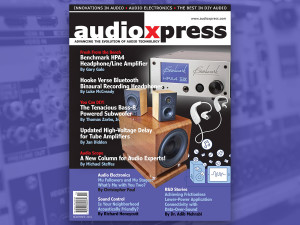 Finally, in Questions & Answers, Shannon Becker interviews Raphael Knoop, the founder of Auverdion, a fledgling company that offers an open-source DSP that he has dubbed Aurora. Following two years of development and a Kickstarter campaign, Knoop turned Aurora into an advanced eight-channel DSP platform with awesome specs, unmatched versatility, and an easy-to-control interface. Effectively, the result of collective thinking, as Knoop shares: "The community will tell you what features are needed to make it successful. Distillate the best ideas from it."
Finally, in Questions & Answers, Shannon Becker interviews Raphael Knoop, the founder of Auverdion, a fledgling company that offers an open-source DSP that he has dubbed Aurora. Following two years of development and a Kickstarter campaign, Knoop turned Aurora into an advanced eight-channel DSP platform with awesome specs, unmatched versatility, and an easy-to-control interface. Effectively, the result of collective thinking, as Knoop shares: "The community will tell you what features are needed to make it successful. Distillate the best ideas from it."
All this content is now available online, and on its way to those who subscribe to the print edition.
To read this edition now, you will need to subscribe to audioXpress. Print and/or Digital subscriptions are available. Subscribe to the digital online version and get immediate access at: www.audioxpress.com/page/audioXpress-Subscription-Services.html
If you wish to buy a single printed issue or the complete audioXpress archive on USB, from 2000 to 2019 (yes, including the latest issue), just visit our online shop at www.cc-webshop.com.
Don't miss out, get your copy of audioXpress right now at www.gotomyxpress.com

- on Magazine News
- News
Are You Serious About Audio Electronics? audioXpress November 2019 Is Now Available!
October 9 2019, 10:35
The November 2019 edition of audioXpress is now available with a wide range of technical topics in audio electronics and design. We review the Benchmark LA4 Line Amplifier and the new Hooke Verse Bluetooth Binaural Recording Headphones. Jan Didden proposes an updated version of his High-Voltage Delay for Tube Amplifiers, and Thomas Zarbo, Jr. explains how to build his Tenacious Bass-8 Powered Subwoofer. And, learn more about Data-Over-Sound, MU amplification topologies, and Auverdion’s Aurora open-source DSP platform. Now available!


